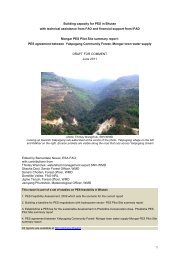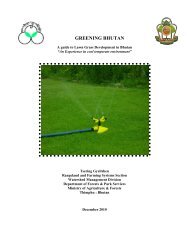Humanâwildlife conflict in the Kingdom of Bhutan: Patterns ... - DoFPS
Humanâwildlife conflict in the Kingdom of Bhutan: Patterns ... - DoFPS
Humanâwildlife conflict in the Kingdom of Bhutan: Patterns ... - DoFPS
Create successful ePaper yourself
Turn your PDF publications into a flip-book with our unique Google optimized e-Paper software.
ARTICLE IN PRESS<br />
2 BIOLOGICAL CONSERVATION xxx (2008) xxx– xxx<br />
and contribute importantly to <strong>the</strong> rural economy, provid<strong>in</strong>g<br />
dependable food and revenue. Practically every <strong>Bhutan</strong>ese<br />
family liv<strong>in</strong>g <strong>in</strong> a rural area owns a small parcel <strong>of</strong> land to<br />
farm subsistence food crops and to keep a variety <strong>of</strong> domestic<br />
animals, pr<strong>in</strong>cipally cattle, horses, yaks, sheep, goats and buffalo.<br />
<strong>Bhutan</strong>ese farmers also depend on nearby forested areas<br />
for non-wood forest products and fuel wood for energy, and<br />
almost all livestock are grazed, at least for part <strong>of</strong> <strong>the</strong> year, untended<br />
<strong>in</strong> pasture or open forest.<br />
One <strong>of</strong> <strong>the</strong> ma<strong>in</strong> contributors to human–wildlife <strong>conflict</strong> <strong>in</strong><br />
<strong>Bhutan</strong> is predation <strong>of</strong> livestock by wild mammalian carnivores<br />
(NCD, 2004; Wang and Macdonald, 2006; Wang et al.,<br />
2006). In <strong>Bhutan</strong>, tiger, snow leopard, leopard, bear, wild dogs<br />
(Cuon alp<strong>in</strong>us) and smaller cats (Felis chaus, F. bengalensis,<br />
F. manul, Pard<strong>of</strong>elis marmorata, Catopuma temm<strong>in</strong>cki, Prionailurus<br />
bengalensis) kill various livestock rang<strong>in</strong>g <strong>in</strong> size from poultry<br />
to large bovids, and have less frequently been responsible for<br />
<strong>in</strong>jury to humans (Sangey, 2000; NCD, 2001a,b; NCD, 2003;<br />
NCD, 2004). Predation <strong>of</strong> livestock by carnivores is related <strong>in</strong><br />
part to <strong>the</strong> type <strong>of</strong> livestock kept, as well as stock management<br />
practices. Wang and Macdonald (2006) cite lax herd<strong>in</strong>g,<br />
<strong>in</strong>adequate guard<strong>in</strong>g <strong>of</strong> stock, and overgraz<strong>in</strong>g as contribut<strong>in</strong>g<br />
factors to livestock loss. However, a host <strong>of</strong> o<strong>the</strong>r factors outside<br />
<strong>of</strong> <strong>the</strong> control <strong>of</strong> <strong>in</strong>dividual farmers such as predator density,<br />
<strong>in</strong>dividual predator behavior, prior experiences <strong>of</strong> <strong>the</strong><br />
predator, natural prey population and predator-prey <strong>in</strong>teractions<br />
are clearly also important (Mishra et al., 2001).<br />
In recent history, human–wildlife <strong>conflict</strong>s have generally<br />
<strong>in</strong>creased across <strong>Bhutan</strong> (NCD, 2004; Wang and Macdonald,<br />
2006). This may be l<strong>in</strong>ked to recent <strong>in</strong>creases <strong>in</strong> <strong>in</strong>come level<br />
and liv<strong>in</strong>g standards that have allowed some farmers to keep<br />
more livestock (Govil, 1999), <strong>in</strong>creas<strong>in</strong>g <strong>the</strong> likelihood that<br />
predators will kill livestock and come <strong>in</strong>to <strong>conflict</strong> with humans<br />
(Seeland, 2000). Abundance <strong>of</strong> domestic stock has<br />
shown to be correlated to ‘predation hotspots’ <strong>in</strong> <strong>Bhutan</strong><br />
(Wang and Macdonald, 2006) and elsewhere (Yom-Tov et al.,<br />
1995; Stahl et al., 2001; Bagchi and Mishra, 2006; Michalski<br />
et al., 2006). Wang and Macdonald (2006) and Wang et al.<br />
(2006) also noted that new conservation legislation enacted<br />
<strong>in</strong> <strong>the</strong> mid-1990s (Forest and Nature Conservation Act <strong>of</strong> <strong>Bhutan</strong>,<br />
1995) placed new restrictions on <strong>the</strong> use <strong>of</strong> common graz<strong>in</strong>g<br />
lands by farmers, and this may have <strong>in</strong>tensified human–<br />
wildlife <strong>conflict</strong> <strong>in</strong> some places. Fur<strong>the</strong>rmore, a central tenet<br />
<strong>of</strong> <strong>the</strong> Act is <strong>the</strong> conservation <strong>of</strong> protected wildlife (<strong>in</strong>clud<strong>in</strong>g<br />
tigers, leopards, snow leopards and bears), however, farmers<br />
<strong>in</strong> central <strong>Bhutan</strong> rank livestock predation as one <strong>of</strong> <strong>the</strong> most<br />
serious threats to <strong>the</strong>ir livelihood, and many farmers express<br />
a desire to eradicate problem wildlife (Wang et al., 2006). If<br />
conservation legislation is to be truly successful <strong>in</strong> conserv<strong>in</strong>g<br />
<strong>Bhutan</strong>’s large predatory mammals, human–wildlife <strong>conflict</strong>s<br />
must be m<strong>in</strong>imized wherever possible. In o<strong>the</strong>r parts <strong>of</strong> <strong>the</strong><br />
Himalayas, high populations <strong>of</strong> domestic livestock have led<br />
to <strong>in</strong>creased predation <strong>of</strong> domestic species by wild carnivores<br />
(Mishra, 1997; Namgail et al., 2007), and <strong>in</strong> most <strong>in</strong>stances, a<br />
heavy f<strong>in</strong>ancial burden is paid by pastoralists (Mishra, 1997;<br />
Maikhuri et al., 2000; Wang and Macdonald, 2006; Namgail<br />
et al., 2007).<br />
Conflict between humans, and carnivores that kill livestock<br />
is a worldwide phenomenon with significant conservation<br />
implications. Well known examples <strong>of</strong> human–carnivore<br />
<strong>conflict</strong> <strong>in</strong>clude hyenas (Crocuta crocuta) and lions (P. leo) <strong>in</strong><br />
Africa (Patterson et al., 2004; Kolowski and Holekamp, 2006);<br />
snow leopards (U. uncia) <strong>in</strong> India and Pakistan (Hussa<strong>in</strong>,<br />
2003; Jackson and Wangchuk, 2004; Bagchi and Mishra, 2006)<br />
wolves (Canis lupus) <strong>in</strong> North America (Musiani et al., 2003),<br />
puma (Puma concolor) and jaguar (Pan<strong>the</strong>ra onca) <strong>in</strong> South<br />
America (Mazzolli et al., 2002; Polisar et al., 2003) and d<strong>in</strong>goes<br />
(Canis lupus d<strong>in</strong>go) <strong>in</strong> Australia (Allen and Sparkes, 2001). Compared<br />
with many regions, however, livestock predation by carnivores<br />
<strong>in</strong> <strong>Bhutan</strong> has not been adequately assessed, with<br />
only one study (Wang and Macdonald, 2006) <strong>in</strong> a s<strong>in</strong>gle National<br />
Park <strong>in</strong> central <strong>Bhutan</strong> hav<strong>in</strong>g been undertaken.<br />
In this paper we report on <strong>the</strong> first two years (October<br />
2003–December 2005) <strong>of</strong> data from ‘The Tiger Conservation<br />
Fund’ (TCF), a scheme established by <strong>the</strong> Government <strong>of</strong> <strong>Bhutan</strong><br />
to compensate farmers for livestock losses to large predators<br />
(Sangay, 2006). Because <strong>of</strong> <strong>the</strong> rigor <strong>in</strong>volved <strong>in</strong> verify<strong>in</strong>g<br />
predation <strong>of</strong> livestock before compensation is paid under this<br />
scheme, we were able to reliably use data ga<strong>the</strong>red by <strong>the</strong> TCF<br />
to exam<strong>in</strong>e seasonal patterns <strong>of</strong> predation by different predators<br />
for different age and sex classes <strong>of</strong> livestock types across<br />
<strong>the</strong> 20 districts (dzongkhags) that toge<strong>the</strong>r comprise <strong>the</strong> K<strong>in</strong>gdom<br />
<strong>of</strong> <strong>Bhutan</strong>. Based on <strong>the</strong>se analyses, we <strong>of</strong>fer recommendations<br />
on how future livestock losses, and thus human–<br />
wildlife <strong>conflict</strong>s, can be m<strong>in</strong>imized <strong>in</strong> <strong>Bhutan</strong>.<br />
2. Methods<br />
2.1. Protocol for <strong>the</strong> assessment <strong>of</strong> claims<br />
A major management challenge to <strong>the</strong> tiger conservation<br />
fund was to only pay compensation where genu<strong>in</strong>e cases <strong>of</strong><br />
livestock predation by <strong>the</strong> wild carnivores covered under <strong>the</strong><br />
scheme had occurred. In this pursuit, a rigorous verification<br />
mechanism was established <strong>in</strong> order to m<strong>in</strong>imize false<br />
claims. The TCF required those mak<strong>in</strong>g a claim to seek three<br />
types <strong>of</strong> evidence before a claim could be processed. First, <strong>the</strong><br />
community leader (Gup) or community representative to <strong>the</strong><br />
National Assembly (Chimi) must support <strong>the</strong> veracity <strong>of</strong> <strong>the</strong><br />
claim. This first step also required that <strong>in</strong>formation about<br />
livestock hold<strong>in</strong>g facilities and <strong>the</strong> stock rear<strong>in</strong>g systems were<br />
collected. Second, a veter<strong>in</strong>arian confirmed, by post mortem<br />
exam<strong>in</strong>ation <strong>of</strong> <strong>the</strong> carcass, that a predator killed <strong>the</strong> animal,<br />
ra<strong>the</strong>r than scaveng<strong>in</strong>g it after death. Third, a local forest or<br />
park staff member confirmed <strong>the</strong> range <strong>of</strong> <strong>the</strong> predator<br />
claimed to have made <strong>the</strong> kill, and cross checked <strong>the</strong> <strong>in</strong>formation<br />
aga<strong>in</strong>st <strong>the</strong> known presence <strong>of</strong> <strong>the</strong> predator locally<br />
through various types <strong>of</strong> <strong>in</strong>direct evidence such as scat,<br />
tracks, and o<strong>the</strong>r signs. Once <strong>the</strong>se three forms <strong>of</strong> documentary<br />
evidence were completed, <strong>the</strong> claim was forwarded to <strong>the</strong><br />
Divisional Forest Officer or Park Manager who fur<strong>the</strong>r evaluated<br />
<strong>the</strong> claim based upon <strong>the</strong> evidence presented. If at that<br />
po<strong>in</strong>t <strong>the</strong> case was supported as valid, it was forwarded to<br />
<strong>the</strong> tiger conservation fund for compensation payment.<br />
Before <strong>the</strong> scheme was put <strong>in</strong>to effect, management conducted<br />
regional tra<strong>in</strong><strong>in</strong>g sessions for community leaders,<br />
foresters and veter<strong>in</strong>arians. Tra<strong>in</strong><strong>in</strong>g focused on understand<strong>in</strong>g<br />
different predatory behaviors, how to recognize feed<strong>in</strong>g<br />
signs <strong>of</strong> predations, <strong>in</strong>direct evidences such as tracks and<br />
Please cite this article <strong>in</strong> press as: Sangay, T., Vernes, K., Human–wildlife <strong>conflict</strong> <strong>in</strong> <strong>the</strong> K<strong>in</strong>gdom <strong>of</strong> <strong>Bhutan</strong>: <strong>Patterns</strong> ..., Biol.<br />
Conserv. (2008), doi:10.1016/j.biocon.2008.02.027





